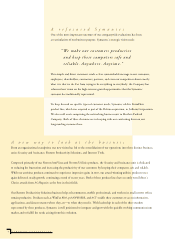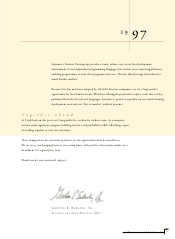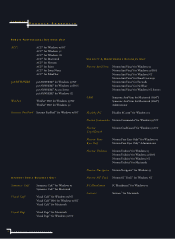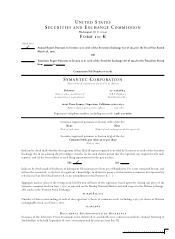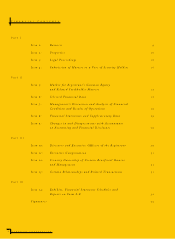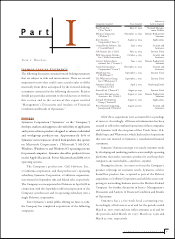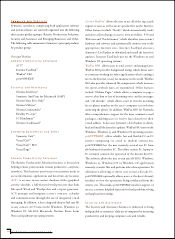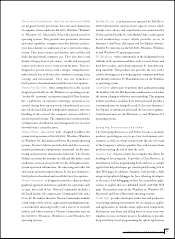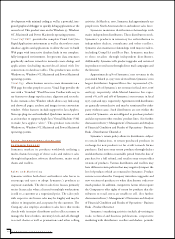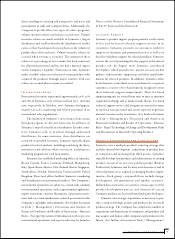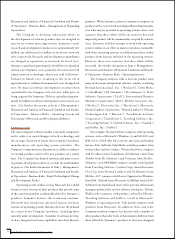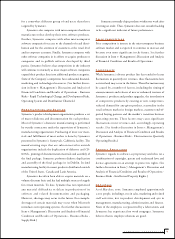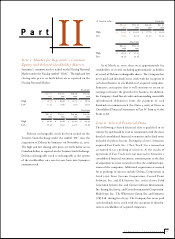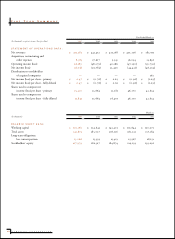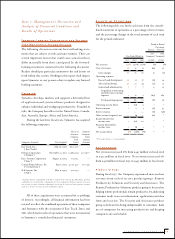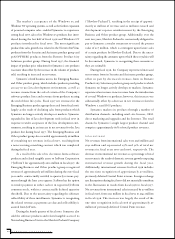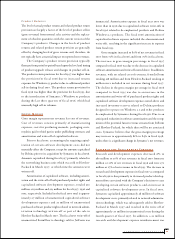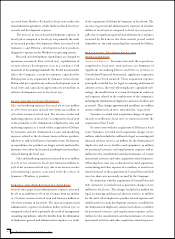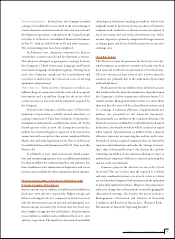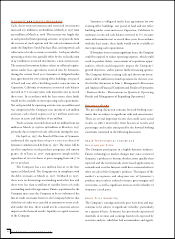Symantec 1997 Annual Report Download - page 16
Download and view the complete annual report
Please find page 16 of the 1997 Symantec annual report below. You can navigate through the pages in the report by either clicking on the pages listed below, or by using the keyword search tool below to find specific information within the annual report.
14 SYMANTEC CORPORATION
products. While Symantec plans to continue to improve its
products with a view toward providing enhanced functionality
over what may be provided in operating systems, there is no
assurance that these efforts will be successful or that such
improved products will be commercially accepted by software
users. Symantec will also attempt to work with operating
system vendors in an effort to make its products compatible
with those operating systems, yet differentiate those utility
products from features included in the operating systems.
However, there is no assurance that these efforts will be
successful. (See further discussion in Item 7: Management’s
Discussion and Analysis of Financial Condition and Results
of Operations - Business Risks - Operating System.)
The Company competes with at least one product from
many of the major independent software vendors, including
Borland International, Inc. (“Borland”), CyberMedia
(“CyberMedia”), Dr Solomon’s (“Dr Solomon’s”), ELAN
Software Corporation (“ELAN”), International Business
Machines Corporation (“IBM”), McAfee Associates, Inc.
(“McAfee”), Microcom, Inc. (“Microcom”), Microsoft,
Norton-Lambert Corporation (“Norton-Lambert”), Phoenix
Technologies Ltd. (“Phoenix”), TouchStone Software
Corporation (“TouchStone”), Traveling Software, Inc.
(“Traveling Software”), Starfish Software, Inc. (“Starfish”)
and SofNet, Inc. (“SofNet”).
For example, Norton Utilities competes with operating
systems, such as Microsoft’s Windows 95 and MS-DOS and
IBM’s DOS, which offer file recovery, anti-virus and backup
features, First Aid from CyberMedia and other products from
various other utilities vendors. Norton AntiVirus competes
with PC-cillin 95 from TouchStone, Dr Solomon’s Anti-Virus
Toolkit from Dr Solomon’s and Viruscan from McAfee.
Symantec’s pcANYWHERE competes mainly with Laplink
from Traveling Software, Carbon Copy from Microcom,
Close Up from Norton Lambert and NetRemote from
McAfee. ACT! competes with Lotus Organizer for Windows
from IBM, Outlook from Microsoft, GoldMine from ELAN,
Sidekick from Starfish and many other personal information
managers produced by various software developers. Delrina
WinFax PRO competes with products offered by Phoenix,
Traveling Software and SofNet, as well as Microsoft’s
Windows 95 operating system. Café mainly competes with
products from Microsoft. In addition, these and other
Company products compete less directly with a number of
other products that offer levels of functionality different from
those offered by Symantec’s products or that were designed
Discussion and Analysis of Financial Condition and Results
of Operations - Business Risks - Management of Expanding
Operations.)
The Company is devoting substantial efforts to
the development of software products that are designed to
operate on various operating systems. Symantec’s total
research and development expenses were approximately $89
million, $95 million and $71 million in fiscal 1997, 1996 and
1995, respectively. Research and development expenditures
are charged to operations as incurred. In fiscal 1997,
Symantec capitalized approximately $8 million of capitalized
software development costs, primarily related to network
administration technology, which was sold to Hewlett-
Packard in March 1997, resulting in the write off of
approximately $7 million of unamortized costs during fiscal
1997. No material software development costs have been
capitalized by the Company in fiscal 1996, while prior to
being acquired by Symantec, Delrina capitalized approxi-
mately $6 million in software development costs in fiscal year
1995. (See further discussion in Item 7: Management’s
Discussion and Analysis of Financial Condition and Results
of Operations - Business Risks - Operating System and
Uncertainty of Research and Development Efforts.)
Competition
The microcomputer software market is intensely competitive
and is subject to rapid changes in both technology and
the strategic direction of major microcomputer hardware
manufacturers and operating system providers. The
Company’s competitiveness depends on its ability to enhance
its existing products and to offer new products on a timely
basis. The Company has limited resources and must restrict
its product development efforts to a relatively small number
of projects. (See further discussion in Item 7: Management’s
Discussion and Analysis of Financial Condition and Results
of Operations - Business Risks - Rapid Technological Change
and Development Risks.)
Operating system vendors such as Microsoft have added
features to new versions of their products that provide some
of the same functionality traditionally offered in Symantec’s
products. Symantec believes this trend may continue.
Microsoft may incorporate advanced features in future
versions of operating systems that may decrease the demand
for certain of the Company’s products, including those
currently under development. A number of software develop-
ers have integrated antivirus capabilities into their Internet


